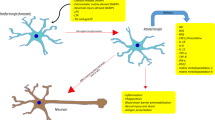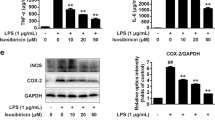Abstract
Chemical genetics is a new field of study that employs diverse small-molecule compounds to interrogate specific biological functions. The chemical genetics approach has been recently applied to microglial biology. Microglial cells are the primary immune cells of the brain, and are believed to play a major role in both host defense and tissue repair in the central nervous system. However, excessive microglial activation with overexpression of proinflammatory cytokines and oxidative stress products is linked to the progression of several neurodegenerative diseases. Therefore, suppression of microglial activation and subsequent neuroinflammation may be a potential therapeutic approach against these diseases. From microglia cell-based assays, the natural compound obovatol and several synthetic compounds were identified as inhibitors of microglial activation. They showed strong anti-neuroinflammatory activities in various in vitro and in vivo studies. Nuclear factor-κB and mitogen-activated protein kinase pathways were found to be related to the effects of these compounds on microglia. In particular, based on the affinity purification approach, peroxiredoxin 2 was identified as a microglial target of obovatol. Thus, natural and synthetic compounds are not only important biological tools for the study of microglial physiology and pathology, but they are also attractive candidates for the development of therapeutic drugs against neuroinflammatory and neurodegenerative diseases.





Similar content being viewed by others
Abbreviations
- CNS:
-
Central nervous system
- NO:
-
Nitric oxide
- LPS:
-
Lipopolysaccharide
- ROS:
-
Reactive oxygen species
- TNF-α:
-
Tumor necrosis factor alpha
- IL-1β:
-
Interleukin 1 beta
- iNOS:
-
Inducible nitric-oxide synthase
- MAPK:
-
Mitogen-activated protein kinase
- ERK:
-
Extracellular signal-regulated kinases
- JNK:
-
c-Jun N-terminal kinase
- NF-κB:
-
Nuclear factor kappa B
- IB4:
-
Isolectin B4
- MCP-1:
-
Monocyte chemoattractant protein 1
- MIP-1α:
-
Macrophage inflammatory protein 1 alpha
- LC–MS/MS:
-
Liquid chromatography–mass spectrometry/mass spectrometry
- Prx2:
-
Peroxiredoxin 2
References
Baeuerle PA, Henkel T (1994) Function and activation of NF-kappa B in the immune system. Annu Rev Immunol 12:141–179
Block ML, Zecca L, Hong JS (2007) Microglia-mediated neurotoxicity: uncovering the molecular mechanisms. Nat Rev Neurosci 8:57–69
Chang LC, Tsao LT, Chang CS et al (2008) Inhibition of nitric oxide production by the carbazole compound LCY-2-CHO via blockade of activator protein-1 and CCAAT/enhancer-binding protein activation in microglia. Biochem Pharmacol 76:507–519
Cho D (2001) Quantitative structure–activity relationship (QSAR) study of new fluorovinylacetamides. Bull Korean Chem Soc 22:388–394
Choi MS, Lee SH, Cho HS et al (2007) Inhibitory effect of obovatol on nitric oxide production and activation of NF-kappaB/MAP kinases in lipopolysaccharide-treated RAW 264.7 cells. Eur J Pharmacol 556:181–189
Ito K, Iida T, Ichino K et al (1982) Obovatol and obovatal, novel biphenyl ether lignans from the leaves of Magnolia obovata Thunb. Chem Pharm Bull (Tokyo) 30:3347–3353
Kawasumi M, Nghiem P (2007) Chemical genetics: elucidating biological systems with small-molecule compounds. J Invest Dermatol 127:1577–1584
Koistinaho M, Koistinaho J (2002) Role of p38 and p44/42 mitogen-activated protein kinases in microglia. Glia 40:175–183
Lee SK, Kim HN, Kang YR et al (2008) Obovatol inhibits colorectal cancer growth by inhibiting tumor cell proliferation and inducing apoptosis. Bioorg Med Chem 16:8397–8402
Lee M, Cho T, Jantaratnotai N et al (2010) Depletion of GSH in glial cells induces neurotoxicity: relevance to aging and degenerative neurological diseases. FASEB J 24:2533–2545
Lee M, Kwon BM, Suk K et al (2011) Effects of obovatol on GSH depleted glia-mediated neurotoxicity and oxidative damage. J Neuroimmune Pharmacol (in press)
McGeer EG, McGeer PL (2003) Inflammatory processes in Alzheimer’s disease. Prog Neuropsychopharmacol Biol Psychiatry 27:741–749
McGeer PL, McGeer EG (2004) Inflammation and neurodegeneration in Parkinson’s disease. Parkinsonism Relat Disord 10(Suppl 1):S3–S7
Meng XL, Yang JY, Chen GL et al (2008) RV09, a novel resveratrol analogue, inhibits NO and TNF-alpha production by LPS-activated microglia. Int Immunopharmacol 8:1074–1082
Morgan SC, Taylor DL, Pocock JM (2004) Microglia release activators of neuronal proliferation mediated by activation of mitogen-activated protein kinase, phosphatidylinositol-3-kinase/Akt and delta-Notch signalling cascades. J Neurochem 90:89–101
Nimmerjahn A, Kirchhoff F, Helmchen F (2005) Resting microglial cells are highly dynamic surveillants of brain parenchyma in vivo. Science 308:1314–1318
Ock J, Suk K (2010) Anti-inflammatory effects of synthetic compound KT-14480 in lipopolysaccharide-stimulated microglia cells. J Pharm Pharmacol 62:279–285
Ock J, Kim S, Suk K (2009) Anti-inflammatory effects of a fluorovinyloxyacetamide compound KT-15087 in microglia cells. Pharmacol Res 59:414–422
Ock J, Han HS, Hong SH et al (2010a) Obovatol attenuates microglia-mediated neuroinflammation by modulating redox regulation. Br J Pharmacol 159:1646–1662
Ock J, Hong SH, Suk K (2010b) Identification of KT-15073 as an inhibitor of lipopolysaccharide-induced microglial activation. Biol Pharm Bull 33:461–467
Ock J, Kim S, Yi KY et al (2010c) A novel anti-neuroinflammatory pyridylimidazole compound KR-31360. Biochem Pharmacol 79:596–609
Pyo MK, Lee Y, Yun-Choi HS (2002) Anti-platelet effect of the constituents isolated from the barks and fruits of Magnolia obovata. Arch Pharm Res 25:325–328
Seo JJ, Lee SH, Lee YS et al (2007) Anxiolytic-like effects of obovatol isolated from Magnolia obovata: involvement of GABA/benzodiazepine receptors complex. Prog Neuropsychopharmacol Biol Psychiatry 31:1363–1369
Stockwell BR (2000) Chemical genetics: ligand-based discovery of gene function. Nat Rev Genet 1:116–125
Stoll G, Jander S (1999) The role of microglia and macrophages in the pathophysiology of the CNS. Prog Neurobiol 58:233–247
Tochtrop GP, King RW (2004) Target identification strategies in chemical genetics. Comb Chem High Throughput Screen 7:677–688
Wyss-Coray T (2006) Inflammation in Alzheimer disease: driving force, bystander or beneficial response? Nat Med 12:1005–1015
Zheng LT, Ock J, Kwon BM et al (2008) Suppressive effects of flavonoid fisetin on lipopolysaccharide-induced microglial activation and neurotoxicity. Int Immunopharmacol 8:484–494
Acknowledgments
The authors’ laboratory was supported by the National Research Foundation (NRF) grant funded by the Ministry of Education, Science and Technology (MEST) of Korean government (No. 2009-0078941). This work was also supported by Basic Science Research Program through the NRF funded by the MEST (No. 2010-0029460).
Conflicts of interest
None to declare related to this study.
Author information
Authors and Affiliations
Corresponding author
Rights and permissions
About this article
Cite this article
Suk, K., Ock, J. Chemical genetics of neuroinflammation: natural and synthetic compounds as microglial inhibitors. Inflammopharmacol 20, 151–158 (2012). https://doi.org/10.1007/s10787-011-0108-2
Received:
Accepted:
Published:
Issue Date:
DOI: https://doi.org/10.1007/s10787-011-0108-2




